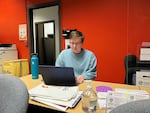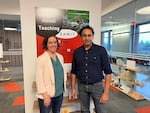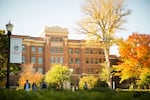It’s been more than a year since many Oregon public universities officially brought students back into the classroom. But Zoe Arinsberg feels students like them are still getting back in the swing of academics.
Arinsberg, a fourth-year student at Oregon State University studying education and psychology, said in-person classes work better for them — they had trouble staying engaged in online classes. But still, coming back to campus hasn’t been the easiest transition.
“I think I lost a lot of my academic skills, like studying,” Arinsberg said. “I forgot how to do that because during the pandemic, a lot of exams would just be open book or that kind of thing just to make it easier on everyone. So it was very weird to have to come back like, ‘How do I study?’”

Zoe Arinsberg works at their office job at Oregon State University. As a fourth-year student, Arinsberg says they've enjoyed returning to in-person classes, but it hasn't been the easiest transition.
Meerah Powell / OPB
The pandemic has had clear effects on the well-being of Oregon college students, including struggles with mental health and food insecurity. What’s been less clear is its impact on college learning.
Worries about learning loss have swirled around K-12 students across the nation. In Oregon, the most recent statewide assessment results showed a steep drop in proficiency in the core subject areas of reading and math. High school and college educators alike say variation in grading rigor over the past few years has helped some students but disadvantaged others. School officials suspect the pandemic caused many students to not pursue college in the first place.
Most of Oregon’s universities saw a flattening or decline in student enrollment. Oregon State University is an exception, as the only public university in the state to see continuous enrollment growth since the start of the pandemic. Its average cumulative grade point average hasn’t changed drastically over the past five years, either.
But even for a school like OSU, where the university appears to be thriving in spite of COVID-19, it’s more complicated than just the data. Students and instructors are searching for the right groove of teaching and learning while entering the third year of the pandemic. Faculty and staff are still constantly assessing how to maintain high academic standards and a return to “normal,” while also providing flexibility that students have gotten used to, and in many cases, still need.
Students continue the transition back to in-person learning
For many students at OSU, the pandemic has provided some clarity on how they best learn and what they want out of their campus experience.
Arinsberg said returning to campus made them realize just how little they were getting from asynchronous online classes.
“I think it was in some ways easy to get through the class but not as easy to learn anything from the class,” Arinsberg said. “It was fairly simple to do the readings and complete the assignments and kind of go through the motions, but I didn’t feel like I was getting that deep knowledge.”
Oregon State halted in-person learning in the spring of 2020. That means fourth-year students like Arinsberg got a little over one full year of normal campus life before the pandemic sent them home to take classes online. Though some hands-on programs and on-campus services continued operating at colleges across the state, at OSU students didn’t fully return until the fall term of 2021.
Draken Reeves, a fourth-year graphic design student at OSU, said he enjoyed online classes for the most part, but being back on campus has been helpful for him academically.
“I feel more community now. I feel like a lot of my education is real in a sense. I think online, it can sometimes feel like you’re not fully learning things, and I think it’s a lot more engaging to be around other people,” he said.
But, getting back into the classroom has both benefits and difficulties.
Although Arinsberg said it’s easier for them to feel more focused in actual classrooms, it’s still taking a while to get used to.
“Everyone’s wanting that engagement and looking for it, but it also feels very rusty and kind of strange,” they said.
Academic researchers say learning online built a certain set of habits and skills for some students such as independent learning and technology problem-solving. But Reeves found it eroded other skills.
“I think there are some ways that I definitely feel like I could be a bit better with my studying habits,” he said. “I think COVID kind of destroyed some of them and made me have to definitely readapt in some ways.”
OSU seeing consistent grades, even if student experiences vary
Regan Gurung is associate vice provost and executive director of the Center for Teaching and Learning and a psychology professor at OSU. He teaches roughly 350 to 400 students a term across his classes. He has compared his students’ final exam scores over the past three years and didn’t find any significant differences.
“Are there explicit changes in [grade point average] or things like that? The answer is no, but it’s those rich, vivid stories,” Gurung said. “Just as there are many students who anecdotally you will hear are not doing well, there are many students who are showing resiliency, who are relying on support, reaching out for support, and doing really well.”
One reason OSU’s grade point average and other academic metrics haven’t declined could be thanks to increased academic support for students.
OSU scaled up some of its academic services in 2021, including its summer bridge program which supports incoming first-year students.
“There was an understanding of learning loss that was starting to happen and then a thinking of, ‘What is it we can do in order to welcome that Fall ‘21 class in?’” said Clare Creighton, director of OSU’s academic success center and writing center.

Clare Creighton (left) and Regan Gurung (right) say they have seen resilience and self-awareness grow in students at OSU over the course of the pandemic.
Meerah Powell / OPB
But Creighton said, solely looking at data, it’s difficult to tell if those increased services have made a unique difference for students impacted by the pandemic, or if the support would’ve provided a similar benefit, whenever it was added.
“The preparedness piece of it and the pre-OSU experience is only one portion of it,” Creighton said. “We can provide support, and we do, and supplemental instruction was scaled up specifically to try and meet that need. But, if we scaled up supplemental instruction in 2017, we might have noticed the same responsiveness and interest from students, so even that is hard to say.”
Students and administrators said they have noticed an interesting benefit of the COVID disruptions: students are gaining self-awareness. Students are identifying how they learn best and what they specifically need from the university and their instructors in order to succeed.
College access may have advantaged students already on higher ed track
There was another change that affected college campuses across the country, including Oregon State: who was applying for college and enrolling — and who was not.
Michelle Buyas is a school counselor on special assignment with the Hillsboro School District. She works with other counselors in elementary, middle and high schools across the district. Before that, she was a high school counselor herself for 15 years. She said she saw many high school students thrive over the past few years of the pandemic — getting into their dream colleges and receiving great scholarships. But Buyas says for the most part, those students were on track for higher education before 2020.
“They were so engaged for the two and a half years that they got normal school. They made such good relationships,” Buyas said. “They still were able to persevere or advocate for themselves, so that [the pandemic] didn’t have as much of an academic impact for them.”
For students who weren’t as engaged before the pandemic began, it’s a different story.

Students walk across Oregon State University's Corvallis campus in this Oct. 27, 2017, file photo.
Bryan M. Vance / OPB
Buyas said there were many high school students who had responsibilities at home that took priority over school, such as taking care of younger siblings and other family members. It was also harder to reach those students as a counselor working virtually during the height of the pandemic.
“I do think that there are lots of pockets of students that could have really accelerated their potential if they had had the right people and circumstances and support,” Buyas said.
Buyas said those students with lower grade point averages could have felt less prepared for college, and might not have even applied in the first place.
According to data from Oregon State, the university has seen a slightly smaller percentage of students with lower GPAs apply over the past few years. In Fall 2018, in-state undergraduate applicants with GPAs lower than 3.0, or a B average, made up 11% of the applicant pool. Last fall, that percentage fell to 9%.
On the other end of the spectrum, the percentage of Oregonians applying to an undergraduate program at OSU with a GPA higher than 3.75 has risen over the past few years — from 38% of the applicant pool in 2018 to 48% last fall.
OSU’s Director of Undergraduate Admissions, Noah Buckley, said that the shift in applicants’ GPA may be due to a variance in grading practices during the last couple of years of the pandemic. School counselor Buyas agrees that it’s part of the equation. Just as flexibility was a priority on college campuses, Buyas said it was necessary in high school, too.
“Our district chose to do some things, and I think other districts probably did other things that affected students’ academics and GPAs differently for the benefit of the students so that we were not giving these extra consequences or impacts to over-penalize students,” Buyas said. “But then what it also does with data is maybe skew how well students are performing.”
Buyas said over the beginning of the pandemic, some districts, including her own, measured student grades based on what students accomplished and the amount they learned, even if there was specific content they didn’t get to. But not learning content that’s expected at a higher level will eventually catch up with students.
“You look a certain way on a piece of paper, but then when you get to college or that next grade level or whatever it is, that’s when you get kind of hit in the face with, ‘Well, I never got to this part before. I don’t know what to do,’” she said.
Creighton, who helps run OSU’s academic success and writing centers, said it’s really too soon to know the full extent of the pandemic’s effects on students.
“I don’t think we’re far enough out to really be able to see what some of the impact is because Fall 2020, Fall ‘21 and Fall ‘22 have been such varied experiences,” she said. “There’s too many variables.”
OSU still finding balance between structure and flexibility
Gurung and Creighton with OSU say that professors have definitely been more flexible over the last few years, but it’s starting to rebalance.
Gurung said OSU’s Center for Teaching and Learning made an effort early on in the pandemic to focus more holistically on the student experience — taking into account the lives of students outside of school and impacts the pandemic has had on mental health.
That included guidance on re-examining late policies and assignment deadlines.
As a faculty member, Gurung said, that wasn’t hard to do since instructors were going through the same struggles that students were.
“I think faculty held this deep, experiential, lived knowledge of what it’s like to go through a really challenging period themselves,” he said.
But, as the university continues through its second academic year with more traditional on-campus offerings, Gurung said there is an effort to pull some of that flexibility back.
“Especially in 2021, I think there was a swing to the far end of flexibility. … There were some courses where they were turn in [assignments] anytime you want,” Gurung said.
He said there’s been a shift back toward tighter deadlines, though not fully.
“It just didn’t go back to the old, in some cases draconian, strictness, but it did ratchet back,” Gurung said. “Complete flexibility isn’t necessarily a good thing. Structure is very good. There are many of our students who greatly benefit from weekly due dates.”
A return to structure also has had benefits for instructors — and not just at OSU.
Portland State University has seen the same shift to more flexibility during the pandemic, said adjunct instructor Erica Thomas. She’s finding a familiar set of pros and cons in the debate around flexibility and structure at her college.
“[M]y rubrics allow me to give grades based on improvement instead of uniform standards, so if a first-generation student doesn’t know what college level writing is like and lands in my classroom, they’re not penalized,” Thomas said via email. “But these modes can do a disservice to the students if rigor is relaxed.”
Thomas also said relaxing academic standards has put more pressure on faculty, especially adjunct faculty.
Thomas said she used to have a flexible policy where students could turn in all of their work at the end of the term, but it was overwhelming to grade that way.
“Being flexible and accommodative is important for student success,” Thomas said. “But it’s hard to do when the university expects us to do these shifts with no extra pay.”
Still, both university employees and students hope some changes caused by the pandemic stick around.
OSU graphic design student Reeves said he has noticed a shift back toward how things were before the pandemic, and he hopes the university evaluates how that could affect students.

Draken Reeves, a fourth-year student at OSU, hopes flexibility and understanding continues to be part of the college experience moving forward.
Meerah Powell / OPB
“I really hope that with the pandemic we would kind of understand and rearrange our work culture in the sense of like, if you’re sick, don’t come in and just infect other people, but it still is kind of like, well, if you miss more than like two classes, you’re kind of screwed,” he said.
“I really do wish that there was still this understanding, and I’m sure there’s instructors out there that do, but from my experience, it seems like they just really want to go back to the way it was, and I don’t think that’s fully sustainable.”
Gurung said one thing that has changed for faculty and students is an increase in communication and compassion. He said he’s had more students open up to him, and likewise, faculty have gained an understanding of their students that they didn’t have before.
“More of us in higher education did what more of us should have been doing for a long time, which was going, ‘It’s not just my class or this class, you’ve got other classes, you’ve got a life,” Gurung said.
“I don’t think you can unlearn compassion.”
